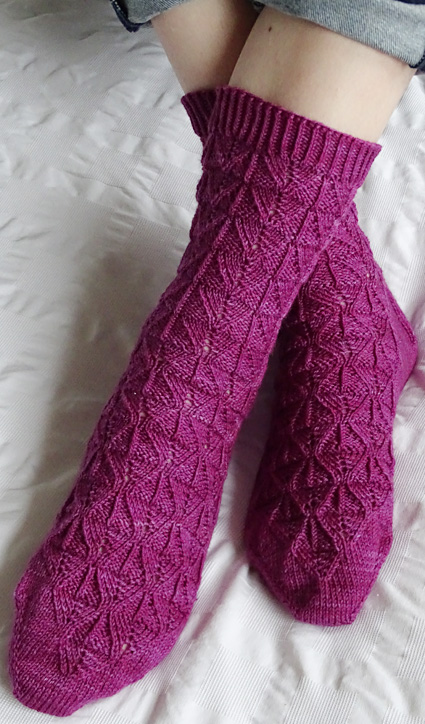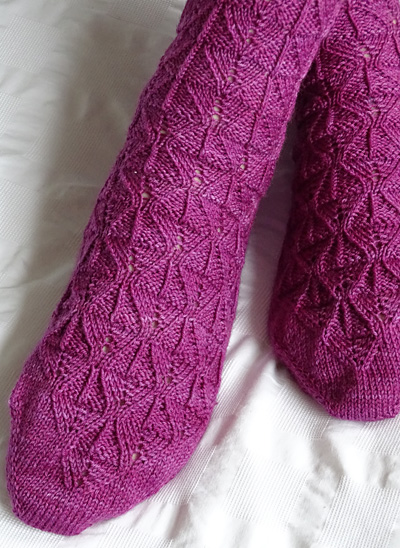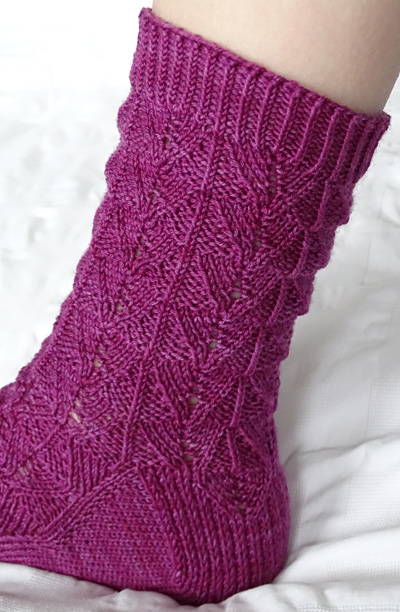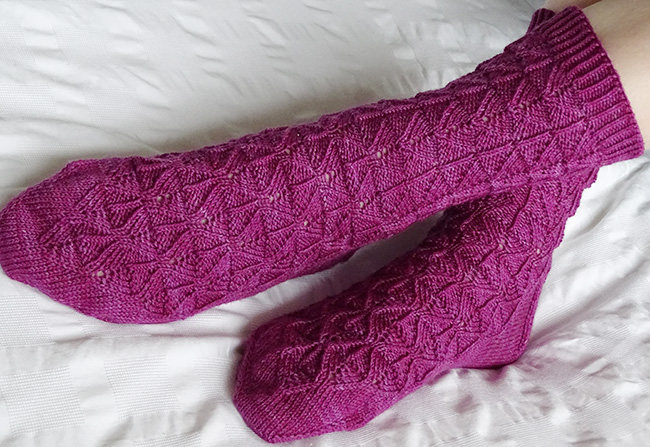

|
|
|

As far as socks go I have always been a cuff-down sort of girl. This has of course led to me avoiding certain designs due to the direction of the pattern. I realized this was just annoying so attempted my first pair of toe-ups 3-4 months ago. Now that I understand the way they are structured, the world is my oyster! I think the texture of this pattern looks very much like a scaly reptilian skin. And when explorers were mapping the world the unknown was often marked “here be dragons”...pretty much as I felt when I attempted my first pair of toe-ups. But don’t let the name faze you! This is a step-by-step pattern which will guide you through the troubled waters of your first toe up sock.
|
||
|
|
Tweet
 |
|
|
|
||
|
SIZE |
|
|
FINISHED MEASUREMENTS |
|
MATERIALS Notions |
|
GAUGE |
| 32 sts/44 rounds = 4 inches in stockinette stitch |
|
PATTERN NOTES |
|
Instructions for Judy's Magic Cast On can be found here: Instructions for Jeny’s Surprisingly Stretchy Bind Off can be found here: |
|
small chart 1 | small chart 2 | medium chart 1 | medium chart 2 | large chart 1 | large chart 2 |
|
DIRECTIONS 
Round 1: Knit, distributing sts across your needles as you prefer. The first 11 sts, the first half of the round is the instep, the second 11 sts, the second half of the round is the sole. Round 2: (K1, M1R, k to 1 st before end of instep, M1L, k2, M1R, k to 1 st before end of sole, M1R, k1. 4 sts increased. Next round, start charts: Work appropriate size Chart A across instep; k1, M1R, k to 1 st before end of sole, M1R, k1. 4 sts increased. Work as set until chart round 6[12, 18] is complete. 58[70, 82] sts - 29[35, 41] sts each for instep and sole. Continue as set, working chart on instep and even on sole, until chart is complete. Foot Work even in pattern as set until foot measures approximately 2 inches less than desired length, ending with an even numbered round of Chart B.  Next round: Work instep as set; k1, M1R, k to 1 st before end of round M1L, k1. 2 sts increased. Next round: Work instep as set, k to end of round. Repeat last two rounds 10 more times. 51[57, 63] sts on sole. Heel 8 sts added to sole, 59[65, 71] sts on sole. This is now the end of the round. Beginning of round moved to start of heel. Heel Flap: Small
Medium
Large
Row 1 [RS]: K43[49, 55], working wrapped sts together with their wraps, SSK, turn. Repeat Rows 3 & 4 until you have worked the appropriate numbers of rows before the heel chart. Work as set until 2 rows remain to be worked, as per the table above. To ensure there is no gap between heel and leg, at the end of each of the next two rows you will slip as stitch from the instep to the heel and w&t as follows: Row 29 [RS]: Work Heel Chart across, w&t (first instep st). Note: the last 2 wrapped sts will be the first & last sts of the top of the foot.

Leg Setup round 1: Starting with stitch 2 of row appropriate of chart E, work Chart E around to end of round, working wrapped stitches together with their wraps (in pattern), until 1 st rems. Work this stitch as stitch 1 of Chart E. Complete pattern rounds up to and including either round 8[10, 12] or round 16[20, 24], whichever is soonest. Continue by repeating the previous 8[10, 12] rounds. That is, if you are starting chart E at round 1 repeat rounds 1-8[10, 12], or if starting at round 9[11, 13] repeat rounds 9-16[11-20, 13-24]) Continue until leg measures approximately 1 inch less than desired length finishing at the end of a pattern block. Cuff: Bind off loosely using an appropriate method such as Jeny’s Surprisingly Stretchy bind off. |
|
FINISHING |
| ABOUT THE DESIGNER |
|
She lives north of Cambridge, England, on the edge of the Fens with her 2 teenage children and husband who all appreciate her sock knitting efforts. The children are most useful for modelling her socks as they fall into the Small and Medium categories. You can find her on Ravelry as RachGentKnits. |
|
Pattern & images © 2015 Rachel Gent. Contact Rachel |